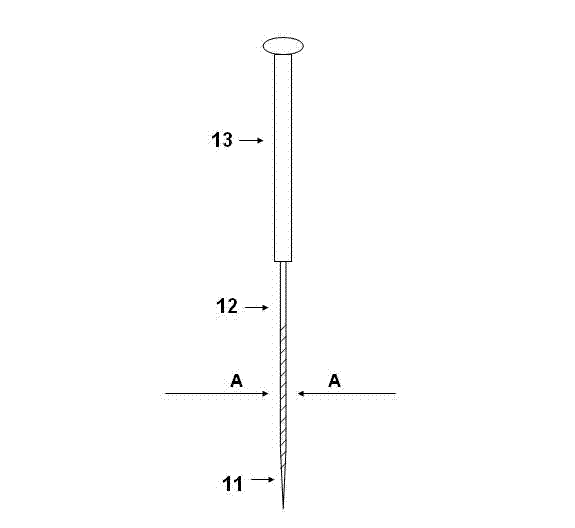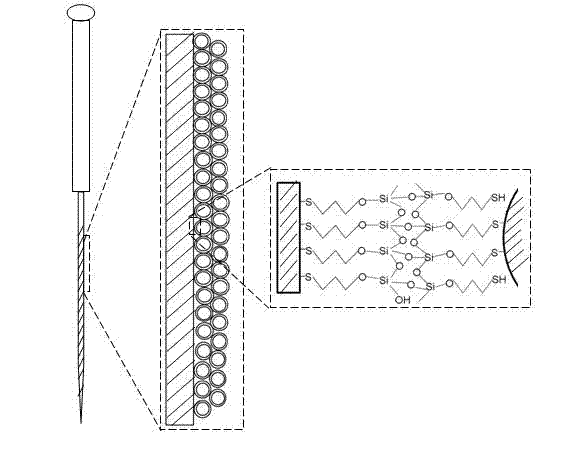Detecting micro-needle with strengthened Raman and fluorescence signal and preparation method thereof
A fluorescent signal and microneedle technology, applied in Raman scattering, fluorescence/phosphorescence, preparations for in vivo tests, etc., can solve the problem of difficult penetration of Raman signals, shorten the detection time and reduce the reagent consumption. Consume and improve the effect of detection signals
- Summary
- Abstract
- Description
- Claims
- Application Information
AI Technical Summary
Problems solved by technology
Method used
Image
Examples
Embodiment 1
[0028] A detection microneedle with enhanced Raman and fluorescence signals, such as figure 1 As shown, the detection microneedle includes: a needle handle 13 , a needle body 12 and a needle tip 11 connected in sequence. Such as image 3 As shown, the metal nanomaterial layer 2 is covered on the surface of the needle body 12 and the needle tip 11 , and the polymer material layer 3 is coated on the metal nanomaterial layer 2 . The particle size of the metal nanomaterial is 20-1000 nm, see Figure 5 , the surface of the needle body and the needle tip is covered with 1-2 layers of gold nanoparticles, and the diameter of the gold nanoparticles is 180nm. In this example,
[0029] The polymer material layer is one of polystyrene layer, polylactic acid layer, polyurethane layer or polyethylene polypropylene fiber layer.
[0030] The metal nanomaterial layer can be one of the following:
[0031] 1) The metal nanomaterial layer is a gold nanoparticle layer, a silver nanoparticle ...
Embodiment 2
[0036] A method for preparing a detection microneedle with enhanced Raman and fluorescence signals, the steps are as follows:
[0037] Step 1) Modifying at least one of amino groups, aldehyde groups, carboxyl groups and hydroxyl groups on the surface of the needle body and needle tip of the microneedle;
[0038] Step 2) Insert the needle body and tip of step 1 into the concentration of 10 8 -10 18 After standing for 12-48 hours in the metal nanoparticle suspension of particles / liter, take out the microneedles;
[0039] Step 3) Insert the needle body and needle tip treated in step 2 into the polymer solution in which the polymer mass to solution volume ratio is 0.1-10% and let it stand for 1-60 seconds, then take it out to obtain the detection microneedle .
Embodiment 3
[0040] Example 3 Preparation of a detection microneedle with enhanced Raman and fluorescence signals
[0041] To obtain functionalized microneedles (methods for modifying thiol groups are known in the art) by modifying the surface of the needle body and tip of the detection microneedles with sulfhydryl groups, adjust the gold nanoparticle suspension to a concentration of 1×10 8-18 pcs / liter. Then the functionalized microneedle is taken out after standing in the gold nanoparticle suspension for 12-48 hours. Due to the chemical bond between the sulfhydryl group on the surface of the microneedles and the gold nanoparticles, the gold nanoparticles will be adsorbed on the surface of acupuncture needles, such as Figure 5 As shown, a nanostructure with uniform 1-2 layer structure and enhanced Raman and fluorescence signals is formed. see figure 2, the metal nanoparticle layer can be connected with the surface of the needle body and the needle tip through groups such as mercapto ...
PUM
| Property | Measurement | Unit |
|---|---|---|
| Particle size | aaaaa | aaaaa |
| Diameter | aaaaa | aaaaa |
Abstract
Description
Claims
Application Information
 Login to View More
Login to View More - R&D
- Intellectual Property
- Life Sciences
- Materials
- Tech Scout
- Unparalleled Data Quality
- Higher Quality Content
- 60% Fewer Hallucinations
Browse by: Latest US Patents, China's latest patents, Technical Efficacy Thesaurus, Application Domain, Technology Topic, Popular Technical Reports.
© 2025 PatSnap. All rights reserved.Legal|Privacy policy|Modern Slavery Act Transparency Statement|Sitemap|About US| Contact US: help@patsnap.com



